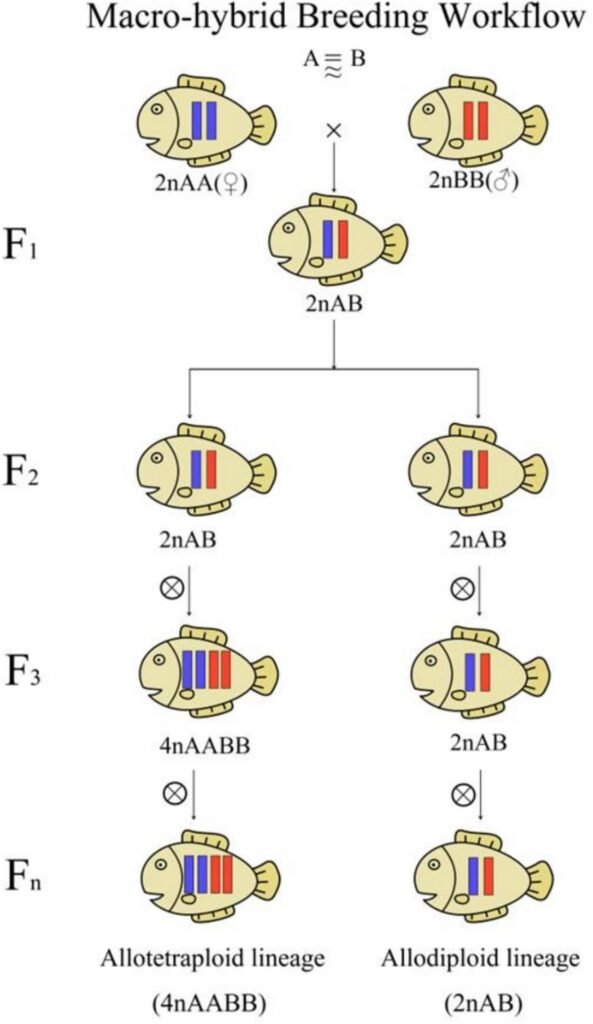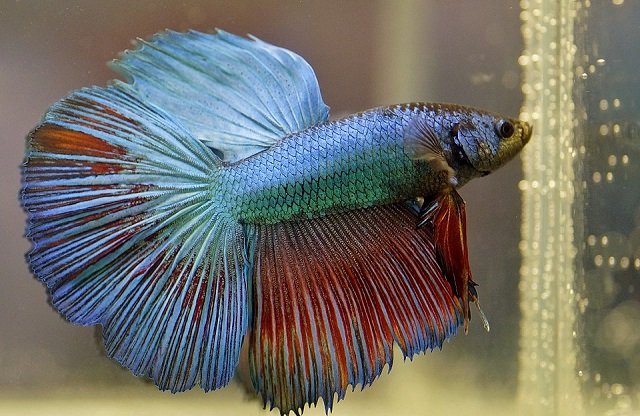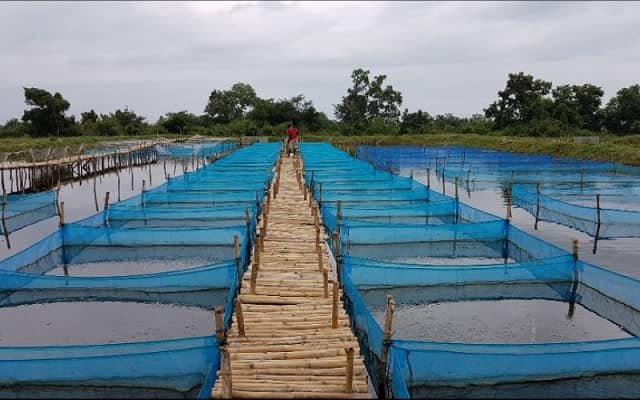
Modern aquaculture faces relentless pressure to sustainably produce more high-quality protein. To achieve this, the industry relies critically on genetic improvement to develop fish that grow faster, resist disease, and adapt better to diverse environments.
For decades, researchers have utilized various tools, from traditional selective breeding to distant hybridization and gynogenesis. However, each technique possesses significant limitations.
A recent, comprehensive review study published in Reviews in Aquaculture by researchers from Hunan Normal University proposes an innovative conceptual framework that integrates two fields (distant hybridization and gynogenesis) under a new paradigm. They introduce the theories of macro-hybridization and micro-hybridization, offering a more precise and effective approach to fish genetic improvement.
Key conclusions
- 1 Key conclusions
- 2 The hurdles of current techniques
- 3 Macro-hybridization: Designing major changes
- 4 Micro-hybridization: Subtle yet powerful improvements
- 5 Gynogenesis as a powerful selection tool
- 6 Solving the “Female-only population” problem
- 7 Conclusion: A new playbook for fish breeding
- 8 Entradas relacionadas:
The paper proposes two new genetic improvement theories: macro-hybridization and micro-hybridization.
- Macro-hybridization (Alloprogenies): Generates significant phenotypic changes and fertile allotetraploid and allodiploid lineages from distant hybridization.
- Micro-hybridization (Autoprogenies): Produces subtle morphological changes but enhances growth and stress resistance by incorporating paternal DNA fragments into a mostly maternal genome.
- Micro-hybridization can be derived from both distant hybridization and gynogenesis induced by heterologous sperm.
- Gynogenesis exerts high selective pressure (homozygosity + heterologous sperm + thermal shock), which helps select for effective genetic variations.
- These theories resolve key challenges of hybridization (low survival, infertility) and gynogenesis (low survival, lack of males).
The hurdles of current techniques
Before defining the new concepts, the study by Liu et al. reviews the current landscape of fish genetic improvement, noting the barriers these new theories seek to overcome:
- Selective breeding: It is the foundation of improvement but is slow, costly, and limited by available genetic diversity, carrying risks of inbreeding.
- Induced polyploidy: The use of physical (cold, heat) or chemical shocks to create triploids or tetraploids has significant limitations, such as teratogenic risk and the difficulty of establishing fertile tetraploid lines.
- Gene Editing (CRISPR): While promising for eliminating intramuscular spines or creating polyploids, its systemic risks are not yet sufficiently evaluated, and it faces barriers to social acceptance.
- Distant hybridization: It is highly effective (responsible for 68% of new hybrid fish varieties approved in China through 2024) but suffers from three major challenges: low survival rates, reproductive difficulties (sterility), and identification problems.
- Gynogenesis: This process, where sperm from another species only activates the egg without contributing genetically (or so it was believed), is useful for creating homozygous populations. However, it suffers from two severe problems: extremely low survival rates (often below 5% or 10%) and the difficulty of expanding the population, as it typically yields only females.
Macro-hybridization: Designing major changes
The first theory proposed is macro-hybridization. This concept is based on traditional distant hybridization but defines and optimizes it.
Macro-hybridization refers to the creation of “alloprogenies” (allogamous progeny) derived from distant hybridization.
- How it works: Crosses are designed between parental species whose chromosome numbers are compatible or very close.
- The result: This chromosomal compatibility allows for the formation of fertile fish lines, whether allo-diploid (containing one set of chromosomes from each parent, AB) or allo-tetraploid (two sets from each parent, AABB). These lineages can propagate stably.
- Main effect: Macro-hybridization induces significant phenotypic (morphological) changes in the offspring.
This strategy has already proven successful in developing superior varieties. Notable examples from the research team include the Hefang crucian carp series (a cross of Japanese white crucian carp and red common carp) and the Hefang blunt-snout bream series (a hybrid of Megalobrama amblycephala and Culter alburnus).
Stay Always Informed
Join our communities to instantly receive the most important news, reports, and analysis from the aquaculture industry.
Micro-hybridization: Subtle yet powerful improvements
Micro-hybridization is perhaps the study’s most innovative concept. It refers to the creation of “autoprogenies” (autogamous progeny).
The key discovery is that, although this progeny possesses a genome predominantly derived from the mother, it also contains small DNA fragments originating from the father.
- How it works: Micro-hybridization can be achieved via two pathways:
- Distant Hybridization: Crossing parents with equal or different chromosome numbers, where the maternal genome predominates, but paternal fragments are inserted.
- Gynogenesis Induced by Heterologous Sperm: Using sperm from a different (inactivated) species to activate the egg, followed by a thermal shock (cold or heat) to duplicate the maternal chromosomes.
- Main effect: Unlike macro-hybridization, the morphological changes are subtle, and the progeny closely resemble the mother. However, the insertion of these small paternal DNA fragments generates significant improvements in growth rate and stress resistance.
Gynogenesis as a powerful selection tool
The study by Liu et al. redefines induced gynogenesis. Traditionally seen only as a way to create homozygotes, the authors argue it is a powerful driver of selection and micro-hybridization.
The artificial gynogenesis process exerts an intense, combined selective pressure from three factors:
- The “Homozygosity Effect”: The duplication of the maternal genome exposes and purges deleterious (lethal or disease-causing) recessive alleles.
- The “Heterologous Sperm Effect”: This is the micro-hybridization. It is considered a form of genetic variation where paternal DNA fragments are inserted, eliminating unfavorable traits and preserving advantageous ones.
- The “Thermal Shock Effect”: The stress from the cold or heat culls the weaker individuals, selecting only the most resilient.
The combination of these three factors is so intense that the research team equates it to 8-10 generations of traditional selection.
Survival rates are extremely low, ranging from 0.01% for mandarin fish to a maximum of 10% for grass carp. But the few individuals that survive are a genetic elite: they exhibit greater resistance to stress, disease, and accelerated growth.
Solving the “Female-only population” problem
One of the biggest drawbacks of gynogenesis (in species with an XX system) is that it only produces females, which prevents large-scale breeding.
The new micro-hybridization technological framework solves this by integrating back-crossing and self-crossing.
The strategy is as follows:
- The original gynogenetic female (with the micro-hybrid effect) is created.
- This female is crossed with a normal (wild) male of her species to produce an F1 generation (which now includes males).
- The F1 is self-crossed to produce the F2 generation.
- Males from the F1 or F2 (carrying the improved traits) can be back-crossed with the original gynogenetic females to amplify the micro-hybrid effect in the population.
This methodology allows for the rapid expansion of the population and has shown that the advantageous traits (like fast growth or resistance) are stably inherited.
Conclusion: A new playbook for fish breeding
The work of Liu et al. (2025) represents a significant advancement by unifying distant hybridization and gynogenesis under one theoretical framework. The theories of macro-hybridization and micro-hybridization are not just academic; they are a practical playbook.
This approach allows genetic breeders to be more precise:
- If drastic phenotypic changes and the creation of new fertile tetraploid lineages are desired, macro-hybridization should be used.
- If the goal is to improve specific traits like growth or stress resistance without drastically altering the species’ morphology, micro-hybridization (especially via gynogenesis) is the indicated tool.
By establishing these technologies, the research team has overcome the three key challenges of distant hybridization (survival, reproduction, identification) and the two main problems of gynogenesis (low survival and population expansion). This conceptual and technical framework provides a solid foundation for the next generation of genetic innovation in aquaculture.
Contact
Shaojun Liu
Engineering Research Center of Polyploid Fish Reproduction and Breeding of the State Education Ministry, College of Life Sciences, Hunan Normal University
Changsha, China
Email: lsj@hunnu.edu.cn
Reference (open access)
Liu, Q., Liao, A., Tao, M., Qin, Q., Luo, K., Zhang, C., Wang, S., Zhou, Y., Hu, F., Wang, Y., Wu, C., Li, W., Liu, Q., Tang, C., Wang, J., Zhao, R., & Liu, S. (2026). Macro-Hybrid and Micro-Hybrid of Fish. Reviews in Aquaculture, 18(1), e70106. https://doi.org/10.1111/raq.70106
Editor at the digital magazine AquaHoy. He holds a degree in Aquaculture Biology from the National University of Santa (UNS) and a Master’s degree in Science and Innovation Management from the Polytechnic University of Valencia, with postgraduate diplomas in Business Innovation and Innovation Management. He possesses extensive experience in the aquaculture and fisheries sector, having led the Fisheries Innovation Unit of the National Program for Innovation in Fisheries and Aquaculture (PNIPA). He has served as a senior consultant in technology watch, an innovation project formulator and advisor, and a lecturer at UNS. He is a member of the Peruvian College of Biologists and was recognized by the World Aquaculture Society (WAS) in 2016 for his contribution to aquaculture.




